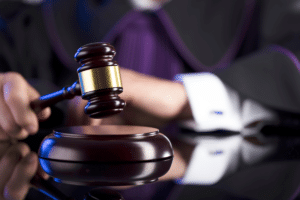In the event that your Longshore Harbor Workers Compensation Act (LHWCA) claim isn’t settled, you’ll need to request a hearing. LHWCA hearings are typically held in front of a federal Administrative Law Judge (ALJ) after an insurer refuses to honor and pay out compensation benefits. When problems such as these arise, the claimant will go through a series of steps, which ultimately lead to the final decision at a hearing.

When LHWCA Claim Problems Arise
In most cases when a maritime worker is injured or contracts an illness on the job, receiving compensation under the Longshore Act is not difficult. The employer or the insurer pays the appropriate amount of compensation for medical treatment and rehabilitation, and the worker returns to the job if he is able to. Permanently disabled workers who can’t return to their jobs receive Longshore Act benefits per the Department of Labor’s Office of Workers’ Compensation Programs (OWCP) guidelines.
However, there are times when either the employer or the insurer denies that an on-the-job injury occurred and rejects the injured worker’s claim. There are also occasions when the worker takes issue with an employer’s actions regarding the benefits. In such instances, the dispute goes to the OWCP for resolution. In general, OWCP district directors try to resolve any issues between the two sides informally. In difficult situations, the directors may have to issue compensation orders. If the dispute is not solved at the district office level, it goes to an ALJ, who decides the outcome based on the merits of the case.
Informal Conferences
In order to resolve a Longshore Act claim dispute, the first step you should take is to request an informal conference with a OWCP district director. District directors have the authority to amicably settle Longshore Act disputes as quickly as possible, and they will try to do so at an informal conference. The informal conference can be conducted in person at the OWCP office or by telephone.
Informal conferences take place, on average, two to three months after you or your lawyer request one. Use this time to gather any documentation about your on-the-job injury, wage records, medical records detailing treatment and costs, and evidence showing that you have been physically disabled during the time mentioned in your LHWCA benefits claim. You may give the documentation to your attorney; you do not have to be present at the informal conference, but your attorney has to present the evidence to the OWCP claims examiner.
When the claims examiner has evaluated both sides’ positions, the informal conference ends with a recommendation. The examiner’s recommendation may favor either of the disputing parties. If an examiner agrees with your claim, the recommendation will state that you should begin receiving benefits.
However, a recommendation is not a legally-binding resolution. If either side chooses to disregard the recommendation, the claims examiner does not have the authority to enforce it. Thus, many employers or insurers ignore the recommendations made by the claims examiner, forcing claimants to request a formal hearing with an ALJ to resolve their case.
Although informal hearings seem unnecessary when employers or insurers ignore the OWCP examiner’s recommendation, they are a mandatory step in the Longshore Act claims process. The claims examiner must issue a written statement summarizing the proceedings at the hearing and the recommendation given.
The Hearing Process
If your employer or the insurer refuses to take action on the OWCP recommendation, your lawyer can request a formal hearing before a federal ALJ. A hearing under the LHWCA is the only legal method to force your employer to take any action to settle your case.
After your lawyer submits a LS-18 form with the Department of Labor, both sides are allowed time to carry out a pre-hearing investigation. This is known as a pre-hearing discovery and resembles the format of standard civil lawsuits. Both sides may ask for documentation, interview witnesses, and exchange written questions. The pre-hearing discovery period may last several months, but once it is complete, your hearing can get under way.
At the formal hearing, both sides of the dispute appear in front of the ALJ. There is no jury present, and the presiding judge, who works with the Department of Labor, will examine the established facts and generally follow the Federal Rules of Procedure.The ALJ will then issue a decision based on the evidence presented by both sides.
The ALJ usually has to make a determination regarding the following questions:
- Did you sustain a work-related injury?
- Was your injury sustained prior to the work-related incident?
- Is your current injury a new one and was your employer responsible?
- Did the work-related accident make an existing injury to become worse?
- How seriously were you disabled by the injury?
- What was your average weekly wage?
- Did you receive a reasonable level of medical treatment?
- Should the insurer pay your medical expenses?
The ALJ’s decision may be reviewed by the Department of Labor’s Benefits Review Board. The Board can either accept or reject the judge’s decision. If necessary, the Board’s decision can be appealed in the U.S. Court of Appeals, and, in some cases, taken to the U.S. Supreme Court.